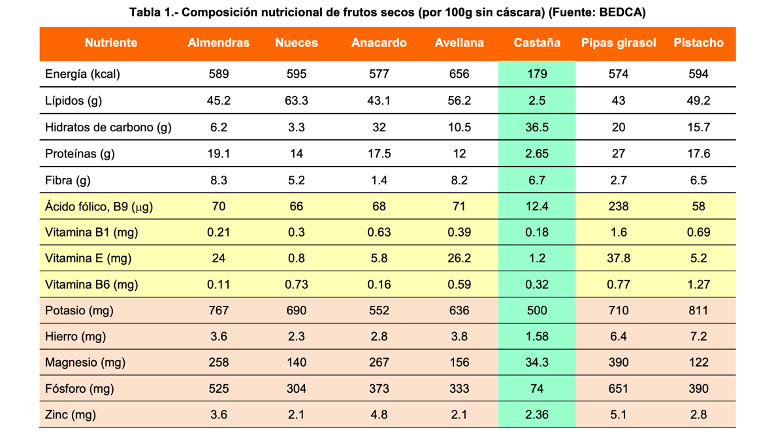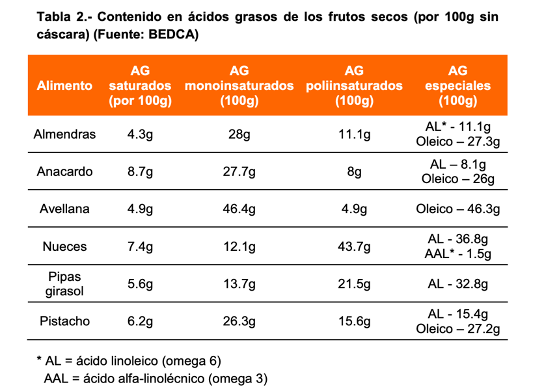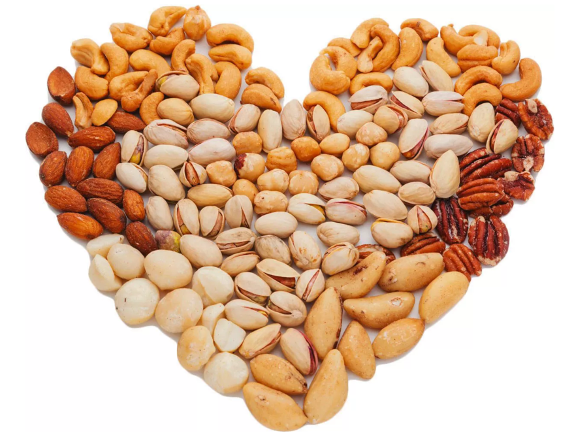Cardioprotective properties have been attributed to nuts, in addition to their special composition in fats, the presence of fiber, vitamins (folic acid, vitamin E, vitamin B6), minerals (calcium, magnesium, potassium, zinc) and other bioactive components, such as antioxidants and phytoesterols.
Nuts are a food group characterized by having high caloric value, since their nutritional composition has over 50% of their weight in fat, with a higher level of monoinsaturated fat (oleic acid in hazelnuts and almonds) and in polyinsaturated fat n-3 (alpha linoeninc in nuts), while containing very little amount of saturated fats.
Carolina Sánchez – Neolife Nutrition and Nursing Unit
Nutritional composition of nuts
Nuts provide energy between 500 and 600 kcal per 100 g of food, except for chestnuts, which are rich in carbohydrates, with low fat and protein content, which means that they do not reach 200 kcal per 100 g, just one third of the energy provided by other nuts. Table 1 (1).

Nuts are naturally rich in unsaturated fatty acids (UFA). Most of them contain significant amounts of monounsaturated fatty acids (MFA), while nuts are particularly rich in polyunstaturated fatty acids (PUFA), in the n-6 (linoleic acid) and n-3 (alpha-linoleic acid) series. The latter belongs to the well-known omega 3 family. Table 2 (1).

Nuts are complex foods that also contain other bioactive compounds with potentially health properties: macronutrients, such as plant proteins and fiber; micronutrients, such as potassium, calcium, magnesium, and tocopherols (vitamin E), and phytochemicals, such as phytosterols and phenolic compounds (2) Like any other food of plant origin, they do not contain cholesterol.
Benefits of nuts in studies
Prospective studies have found an inverse relationship between the consumption of nuts and the risk of cardiovascular mortality. The joint analysis of four large cohort studies: Adventist Health Study, IWHS, NHS, and the Physicians’ Health Study showed a 37% reduction of the risk of coronary death by comparing extreme intake levels. Additionally, it has been estimated that the replacement of saturated fats by 30g/day of nuts may reduce the risk of coronary mortality (3).
With regard to the effect of consumption of nuts on the incidence of Type II Diabetes Mellitus, results are not as consistent. Only three cohort studies analyzed the associations and all three focused exclusively on women; the NHS, the IWHS, and the Shanghai Women’s Health Study. Only a protective effect was found in the study of American nurses and in the cohort of Chinese women (3).
The Multi-Ethnic Study of Atherosclerosis examined the relationship between but consumption and different inflammation markers, and found an inverse relationship between consumption of these foods and levels of fibrinogen, interleukin-6, and C-reactive protein (3).
Certain clinical trials have also found a beneficial effect of nut consumption on different cardiovascular risk factors such as lipid profiles, vascular inflammation, or blood pressure following interventions including nut consumption (3).
These trials have shown that regular consumption of nuts can reduce LDL levels by 10% within a few weeks. A meta-analysis showed that, compared with different control diets, diets rich in nuts achieved greater reductions in total cholesterol and in LDL-cholesterol, showing a higher hypocholesterolemic effect in subjects with higher initial cholesterol levels (3).
The possible properties of this food group would come from its composition in omega -3 fatty acids (mainly in the case of nuts), monoinsaturated fatty acids (MIFA), arginine, vitamin E, folates, fiber, potassium, magnesium, tannins, and polyphenols (3). It is important to highlight that the highest amount of antioxidants is found in the outer cuticle, therefore, it is advisable to eat them raw and with the skin (4).
Despite the high energy contribution of buts, in medium-term studies with daily introduction of nuts in healthy people, no increase in weight was observed. This has been attributed to the satiating effect that results from eating nuts and which ultimately leads to a lower intake of energy-rich foods and, to a lesser extend, to a malabsorption of the fat contained in them, which is less bioavailable than other fats because they are enclosed within cell membranes (4).

In short, nuts can be recommended for routine consumption in all risk groups: people with hypercholesterolemia or high blood pressure, obesity, and/or type II diabetes (4).
At Neolife, considering the benefits attributed in the studies, we recommend daily consumption or at least 3 times a week, of a handful of nuts (equivalent to about 30g) raw and unsalted, preferably without peeling or toasting, because most of the antioxidants are found in the skin. To increase their satiating effect, we advise eating nuts as mind-morning or mid-afternoon snacks and pairing them with a piece of fruit.
BIBLIOGRAPHY
(1) Spanish Food Composition Database (BEDCA): https://bedca.net/
(2) Frutos secos y función endotelial. Emilio Ros. Lipid Unit. Endocrinology and Nutrition Unit. Institut d’Investigacions Biomèdiques August Pi i Sunyer. Hospital Clínic. Barcelona. Ciber CB06/03 Fisiopatología Obesidad y Nutrición. Instituto de Salud Carlos III. Endocrinol Nutr. 2007;54(8):405-7.
(3) Nutrition and clinical dietetics. 3rd Edition. J. Salas-Salvadó, A.Bonadai, R. Trallero, M. Engracia Saló, R. Burgos. Ed. Elsevier Masson.
(4) SEA/SEMERGEN 2019 consensus document.
Diet recommendations in cardiovascular prevention. V. Pascuala, P. Perez, JM. Fernández, R. Soláe, V. Pallarés, A. Romero, F. Pérez y E. Ros. Semergen. 2019;45(5):333-348
